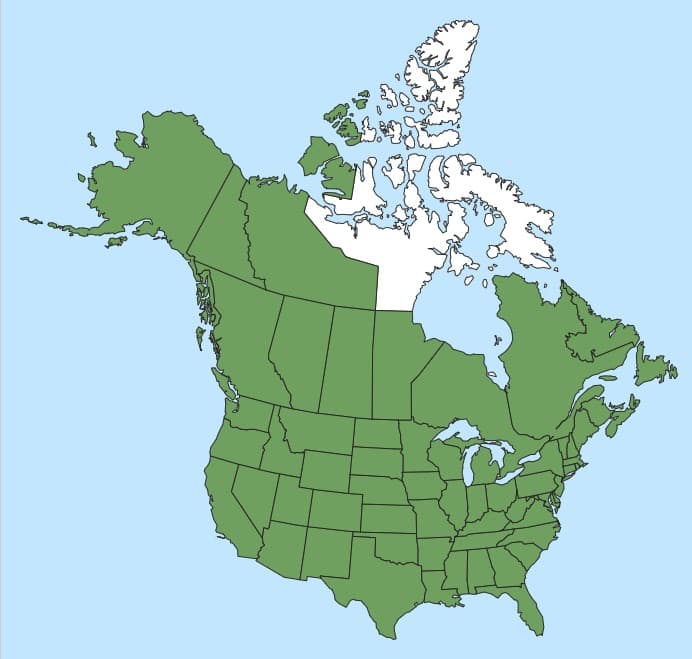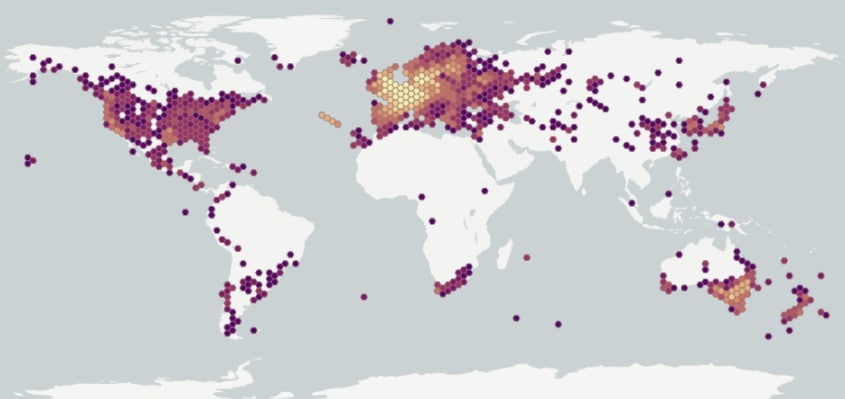Lolium perenne
Explore More :
Explore plus :
Overview
Aperçu
Regulation :
Remarques Réglementation:
Regulation Notes:
Indonesia and Timor-Leste lists of harmful organisms include Lolium spp. (USDA-PCIT-PExD 2021) (*may be updated without notice).
Distribution :
Répartition :
Lolium perenne is native to Europe, Asia and parts of North Africa (Undersander & Cassler 2014; USDA-ARS-2022). It has become naturalized and cultivated in areas of Southern Africa, the Islands in the Western region of the Indian Ocean, Australasia, regions of North America, Central America, the Caribbean and South America (USDA-ARS 2022).
Habitat and Crop Association :
Habitat et Cultures Associées :
Roadsides, open fields, crop fields, pastures, orchards, vineyards, disturbed places, riparian habitats, heath and shrublands, granite outcrops, freshwater wetlands, and coastal beaches (PIER 2013; Identic 2016; UCIPM 2016).
In Australia, some plant communities, and endangered species, such as Lepidium aschersonii (spiny peppercress) and Swainsona plagiotropis (red darling pea), are reported to be threatened by invasive Lolium perenne (Identic 2016; CABI 2022). It also infests Zea mays subsp. mays (maize) and vegetable crop stands (CABI 2022; Cornell University 2022).
Economic Use, cultivation area, and Weed Association :
Utilisation économique, zone de culture et association de mauvaises herbes :
In temperate regions of the world Lolium perenne is predominantly used as a turfgrass and as a forage grass for pasture or hay as it can be grazed closely and frequently (Cattani 2007). As a turfgrass, Lolium perenne provides excellent resistance to trampling as well as quick establishment (Cattani 2007). Furthermore, since Lolium perenne turf allows for a wide range of mowing heights, it is a popular grass for golf courses and athletic fields (Alderson and Sharp 1995; Cattani 2007).
Duration of Life Cycle :
Durée du cycle vital:
Perennial
Dispersal Unit Type :
Type d’unité de dispersion :
Floret
General Information
RENSEIGNEMENTS GÉNÉRAUX
Lolium perenne is a cool-season perennial bunchgrass native to Eurasia. The species has been widely introduced in temperate regions of the world. It is sold commercially alone or in mixtures of species for pasture, hay, lawns, and erosion control (Alderson and Sharp 1995; Barkworth et al. 2007).
Lolium perenne can become invasive if not managed properly, due to its allelopathic nature as well as its ability to tie up available nutrients (Cornell University 2022). In Australia L. perenne is the principal weed species of endangered tableland basalt forests and Eucalyptus conica (fuzzy box) woodlands (Identic 2016).
Lolium perenne intergrades and is interfertile with L. multiflorum. Hybrids of the two species are referred to as Lolium ×hybridum Hausskn. L. perenne also intergrades with L. rigidum (Barkworth et al. 2007).
Fertile natural hybrids of Lolium species and F. pratensis are common in Europe and artificial hybrids have been developed for the commercial market (Barkworth et al. 2007). The hybrid plants have intermediate morphological features and are referred to as Festulolium hybrids (CABI 2022). The following natural hybrid is recognized in the GRIN Database (USDA-ARS 2022): ×Festulolium loliaceum (Huds.) P. Fourn. [= Festuca pratensis × Lolium perenne], a weed common in old pastures, meadows, and roadsides (USDA-ARS 2022).
.Identification
Identification
-
Spikelet
Size
- Spikelet length: 5 – 23 mm; width 1 – 7 mm.*
*Note: size range based on literature sources (Tutin et al. 1980; Barkworth et al. 2007; eFloras 2022).
Spikelet size from literature:
• Spikelet length: 5 – 23 mm; width: 1 – 7 mm (Tutin et al. 1980).
• Spikelet length: 5 – 22 mm; width: 1 – 7 mm (Barkworth et al. 2007).
• Spikelet length: 8 – 20 mm (eFloras 2022).Shape
- Spikelet laterally compressed and oblong-teardrop shaped.
Surface Texture
- Spikelet texture papery and membranous to firm and hardened.
Colour
- Spikelet colour light greenish yellow.
Other Features
Spikelet composition
- The spikelet is composed of 2 – 10 similar looking florets with distal floret usually sterile and slightly smaller in size.**
**Note: spikelet composition based on literature sources (Tutin et al. 1980; Barkworth et al. 2007; eFloras 2022).
Spikelet composition from literature:
• Spikelet with 2 – 10 florets (Tutin et al. 1980).
• Spikelet with (2) 5 – 9 (10+) similar looking florets with distal florets usually sterile and slightly smaller in size (Barkworth et al. 2007).
• Spikelet with 5 – 10 florets (eFloras 2022).Glumes
- Lower glume absent from all spikelets except the terminal spikelet with two glumes; upper glume 3.5 – 15 mm long, one-third the length of spikelet to slightly longer than spikelet (Tutin et al. 1980; Barkworth et al. 2007).
Disarticulation
- Disarticulation of spikelets occurs above the glume and between the florets at the rachilla nodes.
-
Floret
Size
- Floret length*: 4.1 – 9.9 mm (average 6.0 mm); width: 0.9 – 1.9 mm (average 1.3 mm).
- Rachilla length*: 0.7 – 2.3 mm (average 1.4 mm); width: 0.30 – 0.76 mm (average 0.47 mm).
*Note: minimum and maximum based on a combined two samples with a random selection of 40 florets in normal range of this species using image measurement protocol (ISMA 2020).
Size measurements from literature:
• Floret length: 4 – 8.2 mm; width 1 – 2 mm (Barkworth et al. 2007).
• Floret length: 6 – 8 mm; width 1.5 – 1.8 mm (Bojňanský and Fargašová 2007).Shape
- Floret dorsal-ventrally compressed; oblong (sides mostly parallel the entire length) to narrowly teardrop-shaped (lanceolate), not dorsally keeled.
Surface Texture
- Lemma texture papery, finely granular becoming smooth near the tip or with short stiff hairs near margins and apex; palea papery, finely granular in the lower half transitioning to smooth and lustrous in the upper half.
Colour
- Floret colour light greenish yellow.
Other Features
Awn
- Awn, if present, short, straight, and attached slightly below tip.
Callus
- Callus blunt, narrow ridge, bottom edge straight, smooth.
Rachilla
- Rachilla smooth or with short hairs, flat, wide, strap-like, tip usually not expanded.
Palea
- Palea nearly equal in length to lemma.
- Hairs along the keel (palea teeth) short and stiff.
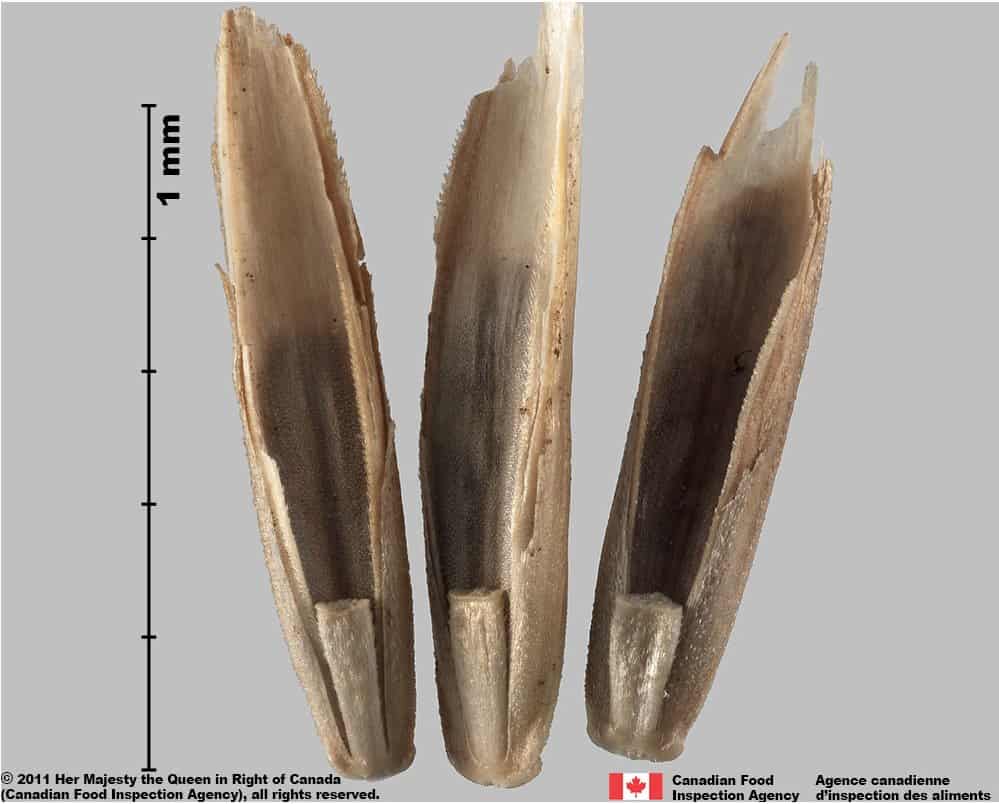
Perennial ryegrass (Lolium perenne) florets

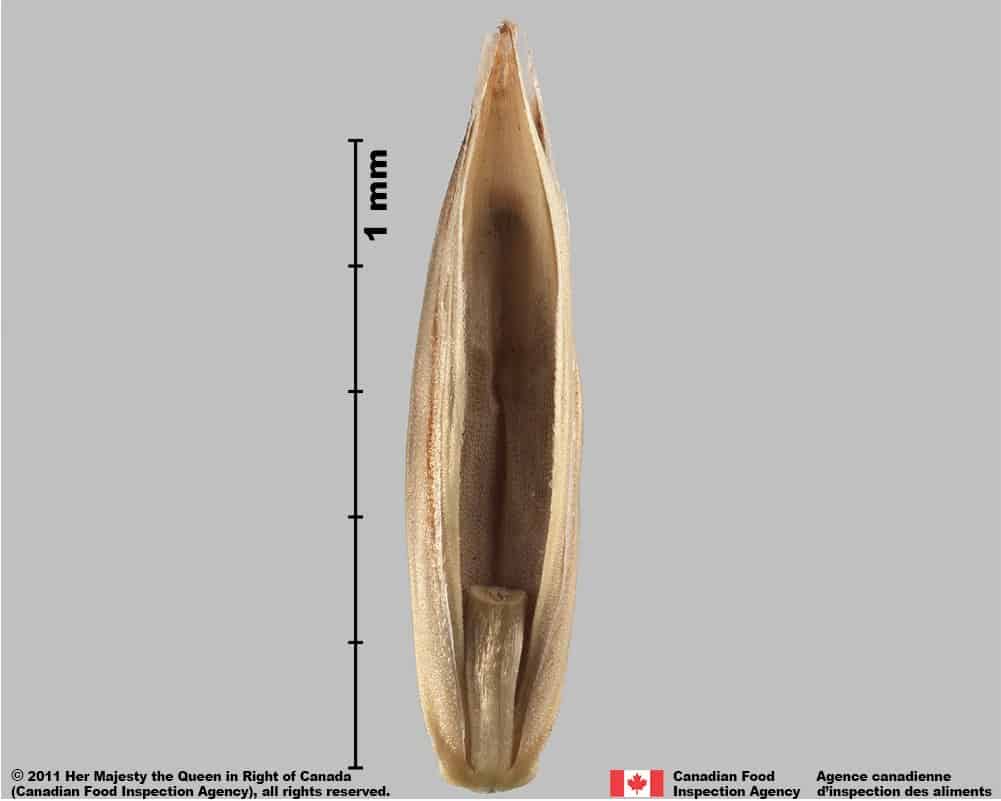
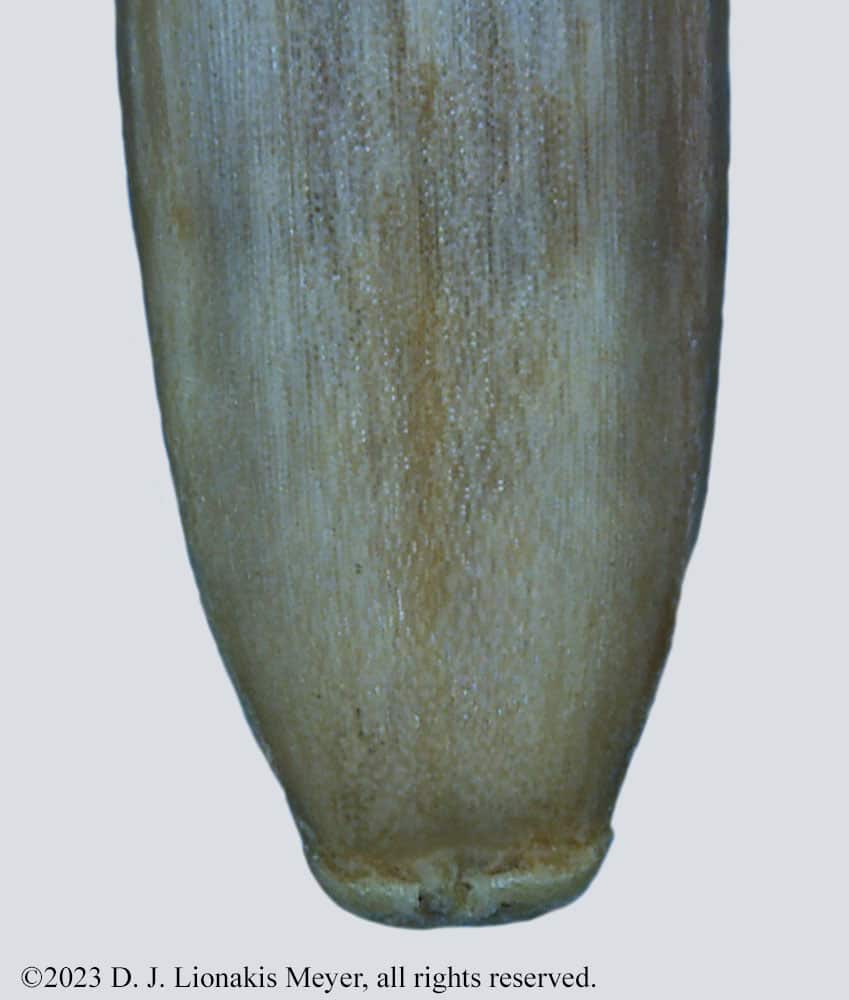
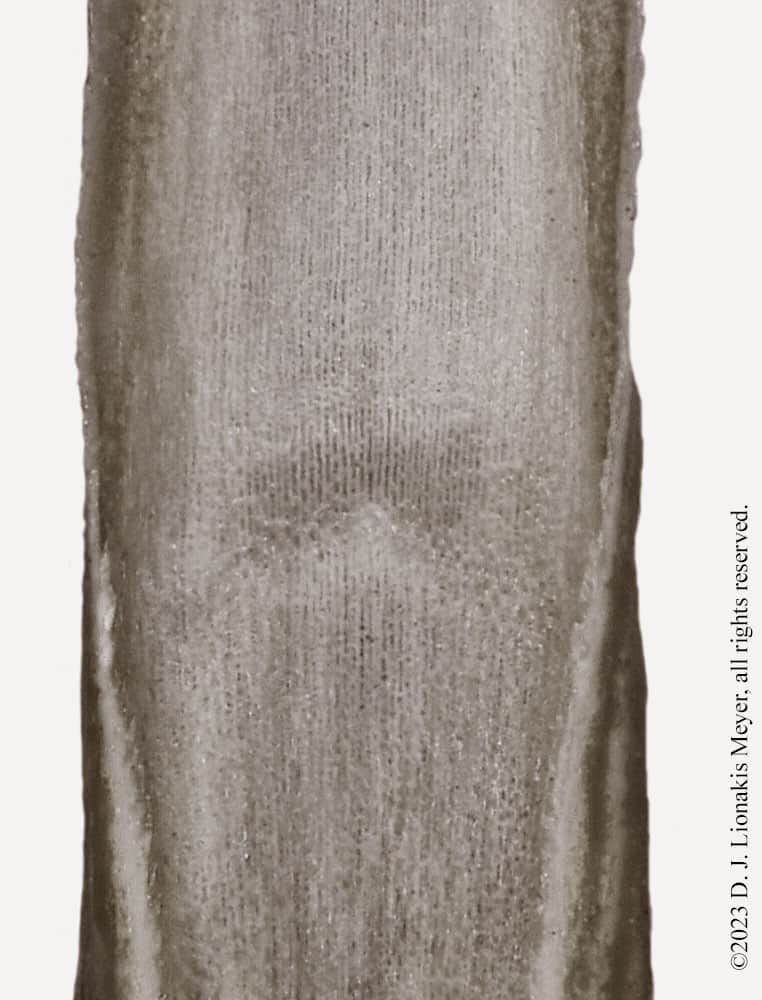
-
Caryopsis
Size
- Caryopsis length*: 2.7 – 5.7 mm long (average 3.7 mm); width: 1.0 – 1.8 mm (average 1.3 mm) wide.
Note:* Minimum and maximum based on 20 caryopses in a normal range of this species using image measurement protocol (ISMA 2020).
Size measurements from literature:
• Caryopsis length: 4.3 – 4.7 mm; width: 1.4 – 1.6 mm (Bojňanský and Fargašová 2007).
• Caryopsis length: 3 – 5.5 mm; width: 0.7 – 1.5 mm, 3 or more times longer than wide (Barkworth et al. 2007).
• Caryopsis length 3 times a long as wide (Tutin et al. 1980; eFloras 2022).Shape
- Caryopsis shape dorsal-ventrally compressed, mostly oblong or oval.
Surface Texture
- Caryopsis texture smooth to slightly rough.
Colour
- Caryopsis colour light to reddish-brown.
Other Features
Hilum
- Hilum linear; hilum length*: 1.8 – 3.9 mm (average 2.5 mm).
Note:* Minimum and maximum based on 20 caryopses in a normal range of this species using image measurement protocol (ISMA 2020).
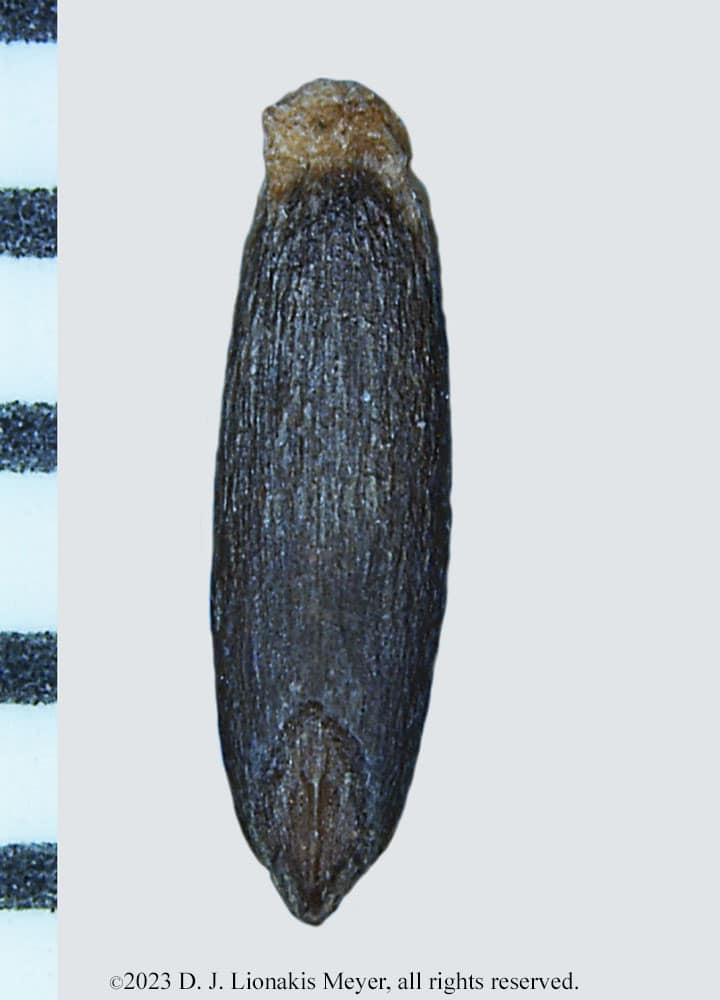
Lolium perenne (perennial ryegrass) caryopsis in embryo view. Scale in mm

-
Embryo
Size
- Embryo length*: 0.6 – 1.5 mm (average 0.9 mm).
- Embryo: about one-quarter the length of caryopsis.
Note:* Minimum and maximum based on embryos of 20 caryopses in a normal range of this species using image measurement protocol (ISMA 2020).
Shape
- Oval or teardrop-shaped.
Endosperm
- Endosperm solid (Terrell 1971).
Other Features
- Embryo position lateral.

Lolium perenne (perennial ryegrass) caryopsis in embryo view. Scale in mm

Identification Tips
CONSEILS POUR L’IDENTIFICATION
- The lemmas of L. perenne are smooth, may have some short stiff hairs near the margins and apex.
- The lemma is usually unawned or may have a very short awn.
- The palea texture is granular in the lower half and smooth and shiny in the upper half.
- The general floret shape is oblong and blunt (squared off) at the base.
- The rachilla segments of L. perenne are flat and strap-like.
- The caryopsis is oval to oblong, dorsal-ventrally compressed, embryo is about one-quarter the length of the caryopsis and the hilum is linear.
- Dispersal units of other Lolium species, in particular L. multiflorum, can be similar and make positive identification challenging. For further identification tips see the comparison table under the similar species section.

Perennial ryegrass (Lolium perenne) floret





Additional Botany Information
AUTRES RENSEIGNEMENTS BOTANIQUES
Flowers/Inflorescence
- Inflorescence spikes 3 – 30 cm long, with 5 – 37 spikelets per spike (Barkworth et al. 2007) and 2 – 10 florets per spikelet.
- Floret size within the spikelet will vary with smaller florets being found near the tip of the spikelet (Cattani 2007).
Vegetative Features
- Plants tufted, and stems erect to horizontal at base and upper stem upright (decumbent), stems to 100 cm tall, sometimes with short rhizomes.
Similar Species
ESPÈCES SEMBLABLES
Similar species are based on a study of seed morphology of various species, and those with similar dispersal units are identified. The study is limited by physical specimen and literature availability at the time of examination, and possibly impacted by the subjectivity of the authors based on their knowledge and experience. Providing similar species information for seed identification is to make users aware of similarities that could possibly result in misidentification.
Festuca pratensis Huds.
Meadow fescue (English) (Wiersema and León 1999; Barkworth et al. 2007; CFIA 2021; AOSA 2022)
Florets of Festuca pratensis, meadow fescue are about the same size and have similar surface texture as L. perenne but the florets of F. pratensis tend to be tapered towards the tip, and the callus forms a thicker ridge. The rachilla segment in F. pratensis is oval to somewhat flattened in cross-section and is straight or twisted to one side, while the rachilla segment of L. perenne is flattened and strap-like. This is a key distinguishing character among the two species for the majority of florets in the spikelet; however, rachilla segments of the small florets from the terminal end of the spikelet in the two species are usually long and slender, rendering this feature in small florets diagnostically unreliable. For further information on this species see the F. pratensis factsheet.
For comparison of diagnostic floret and caryopsis characters of Lolium species please refer to the comparison table below. The floret and caryopsis sizes in these species may overlap making individual florets and caryopses morphologically indistinguishable. In the case of L. perenne and L. multiflorum, separation of these two species require special laboratory testing in which the fluorescence of seedling roots is examined or fluorescent seedlings are grown-out to determine flowering patterns or PCR testing of seeds or seedlings is conducted for detection of the genes involved in flowering control.
Lolium multiflorum Lam.
Annual ryegrass (English) (Wiersema and León 1999; AOSA 2022)
Italian ryegrass (English) (Wiersema and León 1999; AOSA 2022)
Lolium multiforum is an objectionable weed in Australia, India, Nauru, Nicaragua (USDA-PCIT-PExD 2021).
Floret size in L. multiflorum is similar to L. perenne, but the floret may be arched backward on the lemma side and the lemma and palea may be wrinkled. The palea keel hairs (palea teeth) are similar to L. perenne; they are fine, transparent with thick bases, and are closely spaced. The florets of L. multiflorum are commonly awned with awn length up to 6.5 mm or more; however, the seed conditioning process may break off the awns.
*Note: minimum and maximum floret measurements in the comparison table are based on combined two samples with a random selection of 20 florets (CDA-S-23817, n =10; CDA-S-23841, n = 10) and caryopses measurements based on two samples (CDA-S23831, n = 3; CDA-S-23841, n = 2) in normal range of this species using image measurement protocol (ISMA 2020).
Lolium persicum Boiss. & Hohen.
Persian darnel (English) (Wiersema and León 1999; AOSA 2022)
Persian ryegrass (English) (USDA-AMS 2022; AOSA 2022)
Refer to the Lolium persicum factsheet for more information on this species.
Lolium persicum is a Secondary noxious, Class 3 in the Canadian Weed Seeds Order (Government of Canada 2016) under the Seeds Act. This species is a restricted noxious weed seed in Montana and Texas.
The florets of L. persicum are generally larger than those of L. perenne. The palea keel hairs (palea teeth) are long and have thickened bases. Florets are usually awned and the awn can be up to 18 mm (Barkworth et al. 2007). The caryopses of L. persicum are generally larger than those of L. perenne.
*Note: minimum and maximum measurements in the comparison table are based on a random selection of 10 florets and two caryopses in normal range of this species using image measurement protocol (ISMA 2020). CDA-S-23892.
^Note: minimum and maximum measurements in the comparison table are based on a random selection of 10 florets in normal range of this species using image measurement protocol (ISMA 2020). CFIA
Lolium rigidum Gaudin
Wimmera ryegrass (English) (Wiersema and León 1999; AOSA 2022)
Lolium rigidum is an objectionable weed in Brazil, Mexico, Peru, Uruguay (USDA-PCIT-PExD 2021).
The florets of L. rigidum are similar in size to L. perenne. The palea keel hairs (palea teeth) are long, stiff, curved, and with thickened bases. The florets are usually unawned, but the awn can be up to 10 mm long (Barkworth et al. 2007). The caryopses of L. rigidum are similar in size to L. perenne (Barkworth et al. 2007).
*Notes: minimum and maximum measurements in the comparison table are based on two samples and a random selection of 24 florets in normal range of this species using image measurement protocol (ISMA 2020). CDA-S-23913, n = 12; CDA-S-23918, n = 12.
Lolium temulentum L.
Darnel (English) (Wiersema and León 1999; AOSA 2022)
Poison ryegrass (English) (AOSA 2022)
Refer to the Lolium temulentum factsheet for more information on this species.
Lolium temulentum is an objectionable weed in Cambodia, China, Nicaragua, Taiwan, United Republic of Tanzania, Thailand, Uganda (USDA-PCIT-PExD 2021). This species is a restricted noxious weed seed in in at least ten US states.
The general shape of florets in L. temulentum is oblong-oval compared to the oblong shape of L. perenne, and although the floret length in L. temulentum is similar to that of L. perenne, the florets are generally much wider than those L. perenne. The palea side of the floret tends to bulge outward, is usually wrinkled, and the palea keel hairs (palea teeth) are short, stiff, blunt or pointed. The awn is stout and up to 23 mm long (Barkworth et al. 2007).
*Note: minimum and maximum floret measurements in the comparison table are based on one sample with a random selection of 10 florets (CDA-S-23957) and caryopses measurements based on two samples (CDA-S-23952, n = 3; CDA-S-23947, n = 1) in normal range of this species using image measurement protocol (ISMA 2020).
^Note: minimum and maximum measurements based on a random selection of 10 florets in normal range of this species using image measurement protocol (ISMA 2020). CFIA
Comparison of mature floret and caryopsis features of Lolium perenne and similar species of Lolium.
Minimum and maximum measurement of structures in a normal range of these species using image measurement protocol (ISMA 2020 – Meyer* and CFIA^). ** Measurements from Barkworth et al. (2007).
| Feature | L. perenne | L. multiflorum | L. persicum | L. rigidum | L. temulentum |
| Floret shape | Oblong to narrowly teardrop-shaped (lanceolate), dorsal-ventrally compressed nearly flat | Oblong to narrowly teardrop-shaped (lanceolate), dorsal-ventrally compressed nearly flat or may be slightly arched toward lemma side | Narrowly teardrop-shaped (lanceolate), dorsal-ventrally compressed with margins in-rolled toward palea side | Oblong to narrowly teardrop-shaped (lanceolate), dorsal-ventrally compressed nearly flat | Oval, flatten on lemma side and bulging out on palea side (D-shaped in lateral view) |
| Lemma length (mm) | 4.1 – 9.9* | 4.4 – 8.5* | 7.1 – 11.2*
7.9 – 11.2^ |
4.9 – 8.9* | 4.9 – 7.5*
5.3 – 9.1^ |
| Lemma width (mm) | 0.9 – 1.9* | 1.1 – 2.1* | 1.3 – 2.0*
1.8 – 2.4^ |
1.2 – 1.7* | 2.1 – 2.9*
1.9 – 3.4^ |
| Lemma texture | Finely granular in lower two-thirds becoming smooth in upper one-third; may have short stiff hairs near margins and on lateral nerves | Finely granular in lower two-thirds becoming smooth in upper one-third; may have short stiff hairs near margins and on lateral nerves | Granular, with short stiff hairs near tip | Granular in lower two-thirds becoming smooth in upper one-third; covered with short stiff hairs, especially along the margins | Finely granular |
| Awn length (mm) | Usually absent*
Unawned or awns up to 8 mm; attached 0.2 – 0.7 mm below apex** |
0.9 – 6.5*
Attached 0.2 – 0.7 mm below lemma apex; rarely unawned** |
6.5 – 15.3*
8.0 – 18.0**
Attached 0.2 – 1.0 mm below lemma apex** |
0.3 – 2.2*
Usually unawned or awn up to 10 mm** |
7.9 – 15.2*
3.4 – 15.4^
Unawned or awn up to 23 mm; attached 0.2 – 2.0 mm below lemma apex** |
| Palea | Granular in lower half and smooth and shiny in upper half.
Shorter than to slightly longer than lemma. |
Granular in lower half and smooth and shiny in upper half.
Shorter than or slightly longer than lemma. |
Granular in lower half and smooth and shiny in upper half.
Shorter than or slightly longer than lemma. |
Cell pattern granular in lower half and smooth and shiny in upper half.
Shorter than or slightly longer than lemma. |
Coarsely granular in lower two-thirds and smooth and shiny in upper one-third; often wrinkled; margins well exposed.
Shorter than or slightly longer than lemma. |
| Palea keel hairs (palea teath) | Palea keel hairs fine transparent hairs with thicken bases, closely spaced | Palea keel hairs fine transparent hairs with thicken bases, closely spaced | Palea keel hairs long with thickened bases | Palea keel hairs long, curved, and stiff with thicken base – appears like a saw blade | Palea keel hairs short, stiff, blunt or pointed |
| Caryopsis length (mm) | 2.7 – 5.7* | 3.6 – 4.6* | 6.7 – 7.1* | 2.7 – 5.5** | 4.8 – 5.6* |
| Caryopsis width (mm) | 1.0 – 1.8* | 1.5 – 1.7* | 1.7 – 2.0* | 1.0 – 1.5** | 2.4 – 2.8* |
Click to select species
Cliquez pour sélectionner les espèces
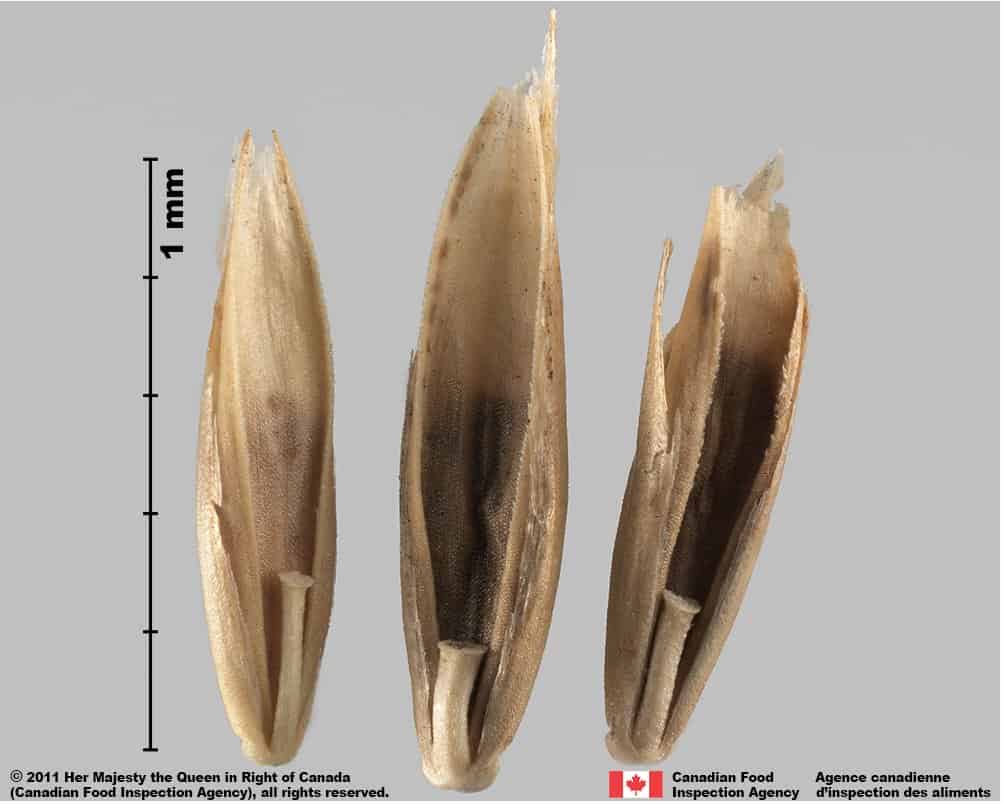
Festuca pratensis
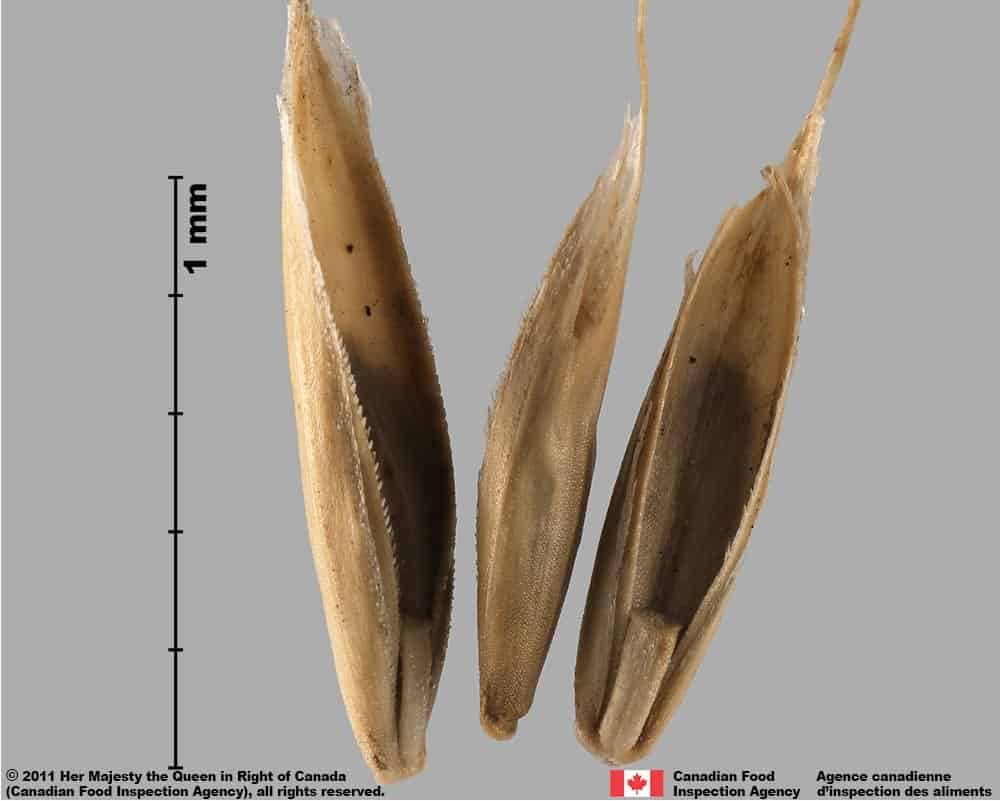
Lolium multiflorum
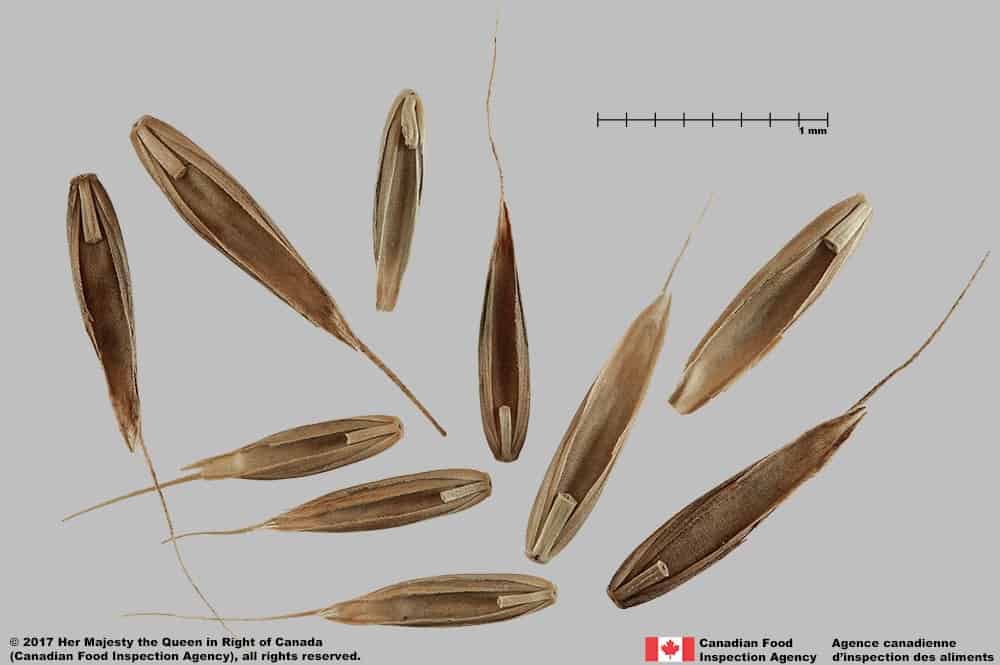
Lolium persicum
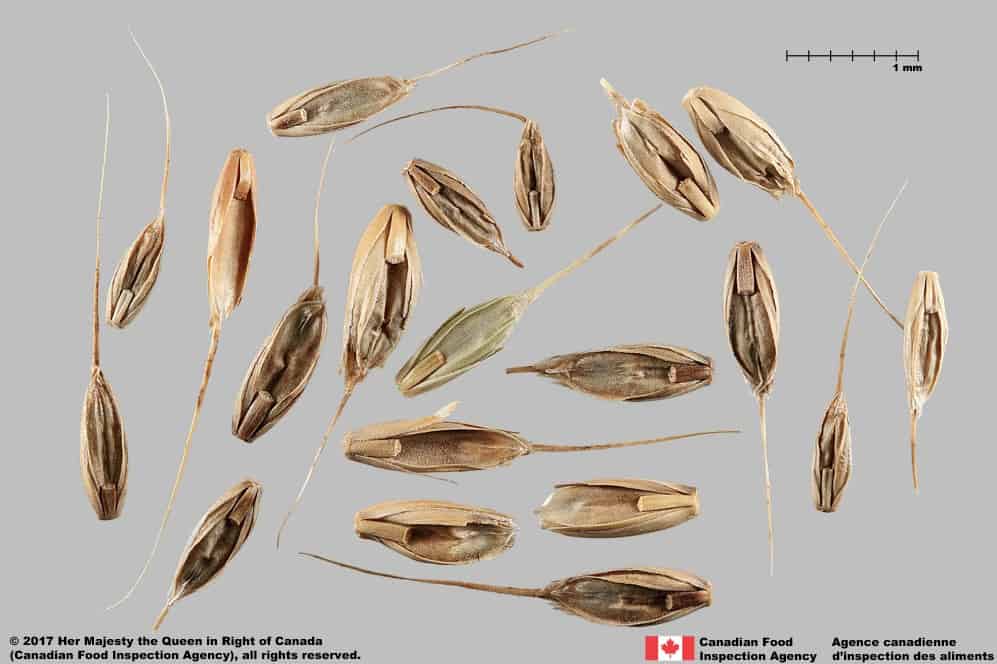
Lolium temulentum
Comparison Window
Fenêtre de comparaison
MAIN SPECIES
ESPÈCES PRINCIPALES
Lolium perenne

Lolium perenne
Poaceae
Perennial ryegrass (Lolium perenne) florets
MAIN SPECIES
ESPÈCES PRINCIPALES
Lolium perenne

Lolium perenne
Poaceae
Perennial ryegrass (Lolium perenne) floret
MAIN SPECIES
ESPÈCES PRINCIPALES
Lolium perenne

Lolium perenne
Poaceae
Lolium perenne (perennial ryegrass) close up of callus.
MAIN SPECIES
ESPÈCES PRINCIPALES
Lolium perenne

Lolium perenne
Poaceae
Lolium perenne (perennial ryegrass) close up view of palea texture.
MAIN SPECIES
ESPÈCES PRINCIPALES
Lolium perenne

Lolium perenne
Poaceae
Lolium perenne (perennial ryegrass) caryopsis in embryo view. Scale in mm
SIMILAR SPECIES
ESPÈCES SEMBLABLES
Festuca pratensis

Festuca pratensis
Poaceae
Meadow fescue (Festuca pratensis) florets
SIMILAR SPECIES
ESPÈCES SEMBLABLES
Festuca pratensis
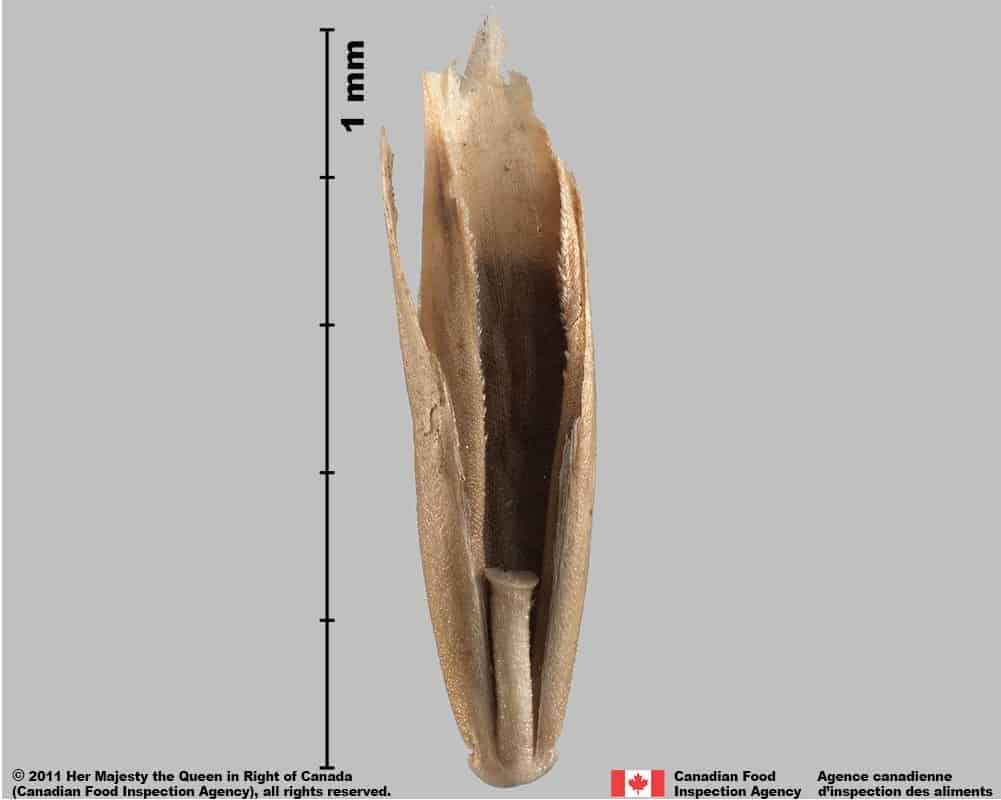
Festuca pratensis
Poaceae
Meadow fescue (Festuca pratensis) floret
Need ID Help?
Besoin d’aide pour l’identification?
Reference(s)
Référence(s)
Aldén, B., S. Ryman, & M. Hjertson. 2012. Svensk Kulturväxtdatabas, SKUD (Swedish Cultivated and Utility Plants Database; online resource) www.skud.info
Alderson, J. & W. C. Sharp. 1995. Grass varieties in the United States, U.S.D.A. Agric. Handbook 170, rev. ed. CRC Press.
Association of Official Seed Analysts (AOSA). 2022. Rules for Testing Seeds, Vol. 3: Uniform Classification of Weed and Crop Seeds. Association of Official Seed Analysts, Washington D. C.
Barkworth, M. E., Capels, K. M., Long, S. and Piep, M. B. (eds.). 2007. Flora of North America Volume 24. Magnoliophyta: Commelinidae (in part): Poaceae, part 1. Oxford University Press, New York, New York.
Bojňanský, V. and Fargašová, A. 2007. Atlas of Seeds and Fruits of Central and East-European Flora: The Carpathian Mountains Region. Springer, Dordrecht, The Netherlands.
Canadian Food Inspection Agency (CFIA). 2021. Canadian Methods and Procedures for Testing Seeds (M&P). Version 1.1, English. Canadian Food Inspection Agency.
Cattani, D. J. (2007). Perennial Ryegrass Seed Production. Forage Seed Manitoba Agriculture, Food and Rural Initiatives Crops Knowledge Centre, Carman MB. https://www.umanitoba.ca/faculties/afs/MAC_proceedings/proceedings/2007/Doug_Cattani.pdf.
Centre for Agriculture and Bioscience International (CABI). 2022. Invasive Species Compendium, CAB International, Wallingford, UK. Lolium perenne (perennial ryegrass) – Datasheet. CABI – Invasive Species Compendium. https://www.cabidigitallibrary.org/doi/10.1079/cabicompendium.31166 Accessed August 24, 2022.
Cornell University. (2022). Perennial ryegrass. Cornell Weed Identification – Agricultural Weed ID for New York State. https://blogs.cornell.edu/weedid/perennial-ryegrass/. Accessed August 24, 2022.
eFloras. 2022. Electronic Floras (Flora of China). Missouri Botanical Garden, St. Louis, MO & Harvard University Herbaria, Cambridge, MA., http://www.efloras.org Accessed July 28, 2022.
Government of Canada (GC). 2016. Canadian Weed Seeds Order. https://laws-lois.justice.gc.ca/eng/regulations/SOR-2016-93/page-2.html (English) https://laws-lois.justice.gc.ca/fra/reglements/DORS-2016-93/page-2.html (French)
Henderson, L. 2001. Alien weeds and invasive plants: a complete guide to declared weeds and invaders in South Africa. Plant Protection Research Institute, Handbook 12.
Identic. (2016). Lolium perenne L. Fact Sheet. Weeds of Australia. https://keyserver.lucidcentral.org/weeds/data/media/Html/lolium_perenne.htm. Accessed August 24, 2022.
International Seed Morphology Association (ISMA). 2020. Method for seed size measurement. Version 1.0. ISMA Publication Guide. https://www.idseed.org/authors/details/method_for_seed_size_measurement.html.
International Seed Testing Association (ISTA). 1982. A Multilingual Glossary of Common Plant-Names 1. Field crops, grasses and vegetables, ed. 2.
Pacific Island Ecosystems at Risk (PIER). 2013. Lolium perenne L., Poaceae. http://www.hear.org/pier/species/lolium_perenne.htm. Accessed August 24, 2022.
Rehm, S. 1994. Multilingual dictionary of agronomic plants. Kluwer Academic Publishers, Dordrecht, Netherlands.
Terrell, E. E. 1971. Survey of occurrences of liquid or soft endosperm in grass genera. Bull. Torr. Botan. Club 98(5):264-268.
Tutin, T. G., Haywood, V. H., Burges, N. A., Moore, D. M., Valentine, D. H., Waters, S. M., Webb, D. A. (Eds.). 1980. Flora Europaea. Volume 5: Alismataceae to Orchidaceae (Monocotyledons). Cambridge University Press.
Undersander, D. & Casler, M. 2. Ryegrass Types for Pasture and Hay. University of Wisconsin-Extension. https://fyi.extension.wisc.edu/forage/files/2017/04/Ryegrass-Types-for-Pasture-and-Hay.pdf.
United States Department of Agriculture-Agricultural Marketing Service (USDA-AMS). 2022. State Noxious-Weed Seed Requirements Recognized in the Administration of the Federal Seed Act. https://www.ams.usda.gov/sites/default/files/media/StateNoxiousWeedsSeedList.pdf Accessed August 23, 2022.
United States Department of Agriculture-Agricultural Research Services (USDA-ARS). 2022. Germplasm Resources Information Network (GRIN), https://npgsweb.ars-grin.gov/gringlobal/taxon/taxonomysearch Accessed August 24, 2022.
United States Department of Agriculture-Phytosanitary Certificate Issuance and Tracking System-Phytosanitary Export Database (USDA-PCIT-PExD). 2021. Phytosanitary import requirements of U.S.-origin commodities to foreign countries. https://pcit.aphis.usda.gov/PExD/faces/ViewPExD.jsp. Accessed November 11, 2021.
University of California (UCIPM). 2016. Ryegrasses (Lolium spp. Italian ryegrass (Lolium multiflorum) Perennial ryegrass (Lolium perenne)). Agriculture and Natural Resources, University of California. http://ipm.ucanr.edu/PMG/WEEDS/ryegrasses.html. Accessed August 24, 2022.
Wiersema, J. H. and León, B. 1999. World economic plants: a standard reference. CRC Press, Boca Raton, FL.



